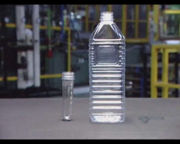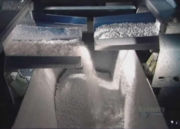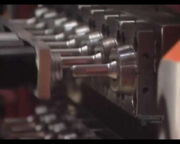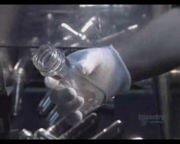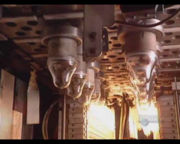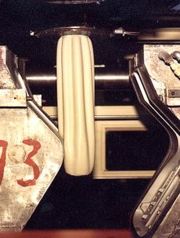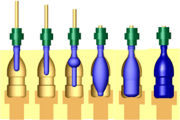Blow molding
From DDL Wiki
Contents |
Definition
Blow molding is used to manufacture hollow plastic parts, and can be performed via extrusion, injection or stretch processes. All process use some type of extruded or injected preform called a parison, compressed air and a mold shaping the final container. The final product is a any type of strong container or bottle-like vessel.
Process
General Process
The process of injection blow molding begins with plastic, typically Polyethylene terephthalate, pellets that are melted at high temperature.
The plastic is quickly cooled and the plastic shape hardens, having taken the form of the larger mold, but with a hollow center.
There are many variations in this process, such as the following:
Extrusion blow molding (EBM)
- Plastic is extruded into a hollow tube (called a parison).
- Melted plastic accumulates at end of barrel around which tube is extruded, closing the form.
- The parison is captured in a metal mold.
- Air is blown into the cavity, stretching the parison into the desired shape.
- The part is removed from the mold after sufficient cooling.
EMB can be continuous or intermittent. If it is continuous, blow molds may either rotate or shuttle with respect to a fixed extrusion head. In intermittent processes, the molds are stationary and the parisons are dropped into them.
Injection blow molding (IBM)
- Molten plastic is injected into a hollow mold around a core rod.
- The outer mold is removed.
- The remaining core rod and initial form are clamped into a cooled blow mold.
- The rod is removed and pressurized air creates the final shape.
This is the least common type of blow molding, for use with small bottles or one time only applications.
Stretch blow molding (SBM)
- Forming of parison.
- Parison placed into neck of bottle (final mold).
- Core rod stretches parison into bottle, with an initial air pressure of 70 to 350 psi.
- When stretch rod reaches the bottom of mold, pressure is increased to 580 psi creating the final form.
This type is most preferable because it offers optimal structural and cosmetic advantages, especially in the case of withstanding forces of carbonated beverages. Also, there is no resulting flash, but only a line where the mold halves meet.
Design Considerations
Injection molding is optimal for situations where a large number of low-tolerance plastic or glass parts with a single hollow are required.
Geometric Constraints
When considering blow molding as the process to be used to produce a product, one must realize that this blow molding can only create thin-walled hollow containers. This process can also create parts that have hollows, and shapes that allow for the blow mold to separate. Due to the nature of injection molding, the single hollow is extremely important. This type of manufacturing method is best for creating simple a simple hollow in either glass or plastic, ideally in a two-part cast. An additional design consideration is the geometry of the walls of the cast part. Walls should be slightly angled to facilitate the separation of the mold from the cast.
Material Constraints
Materials used for injection blow molding must be able to be extruded and blown. Since the process requires these two distinct properties, thermoplastics such as polyethylene and polypropylene are used. These plastics have the property of becoming flexible once reheated during the blowing process.
Mold Constraints
The casting molds that have to be used must be made of very high quality “aviation-type” aluminum or better. These molds must be very reusable with no deformities, and be able to handle the temperatures of the heated plastics.
Cost
Sources
- Kalpakjian, Serope. Manufacturing Processes for Engineering Materials, 3rd ed. Menlo Park, CA. Addison Wesley Longman. 1997.
- Segment A, Plastic Bottles & Jars. "How It's Made." Discovery Channel. Season 4, Episode 1.
- Segment C, Plastic Gas Containers. "How It's Made." Discovery Channel. Season 1, Episode 11.
